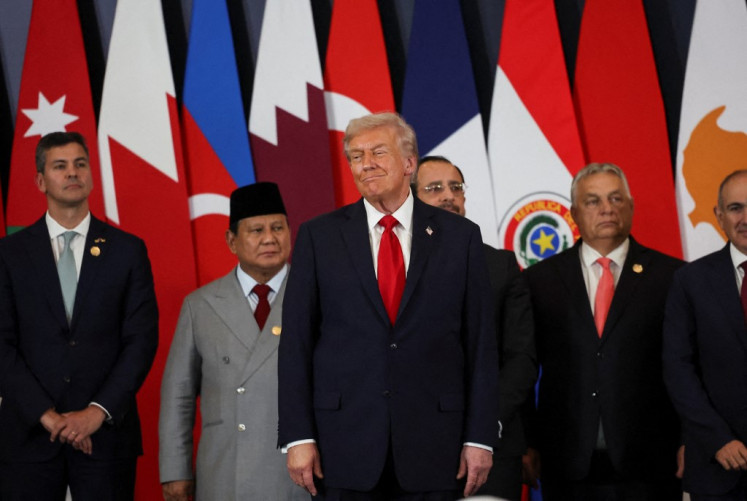Popular Reads
Top Results
Can't find what you're looking for?
View all search resultsPopular Reads
Top Results
Can't find what you're looking for?
View all search results`KBBI': Praise, critique from a language user
This year's release of the forth edition of the Great Dictionary of the Indonesian Language of the Language Center (Kamus Besar Bahasa Indonesia Pusat Bahasa) deserves a huge applause as an important academic achievement by the Indonesian Language Center and at the same time a great contribution to the field of lexicography in the country
Change text size
Gift Premium Articles
to Anyone
T
his year's release of the forth edition of the Great Dictionary of the Indonesian Language of the Language Center (Kamus Besar Bahasa Indonesia Pusat Bahasa) deserves a huge applause as an important academic achievement by the Indonesian Language Center and at the same time a great contribution to the field of lexicography in the country.
Under its head, Dendy Sugono, the Language Center has been playing an active role in its attempt to help modernize the Indonesian language, particularly the development of its lexicon.
With more than 90,000 entries, the forth edition of the dictionary clearly proves that Indonesian is a modern and open language that welcomes and constantly accommodates the influx of Western words and terminologies.
Moreover, the sharp increase in terminologies taken from indigenous languages such as Dayak, Gayo, Madura, Minahasa, Mimika and Wamena, to mention just a few, partly demonstrates the Center's commitment to preserving the richness of the country's local languages.
Compared to its predecessors, this year edition sees a significant increase in the numbers of entries. The first edition (1988, under Anton M. Moeliono) contained 62,000 entries, the second (1991, under Lukman Ali) 68,000, and the third (2000, under Hasan Alwi) 78,000.
The increase of entries in the latest edition shows a clear sign that, linguistically, Indonesian still needs to either borrow or adopt words and terminologies from other languages (both foreign and local). This is motivated by some fundamental reasons.
First, there is a need to fill the existing lexical gap in Indonesian. Just as the English language adopts words from other languages such as French (garage), Italian (piano), Arabic (sofa), Tahititian (tattoo), Japanese (tycoon), Turkish (yogurt), and Bantu (Zebra), Indonesian also adopts words from either Western or its indigenous languages in order to designate novel referents, which are not readily available in its lexical stock.
Second, the inadequacy of semantic field in Indonesian leads to the adoption and borrowing from other languages. Words and terminologies derived from other languages enter Indonesian simply because they provide a subtle and specific nuance whose equivalents can't be precisely expressed in Indonesian. For register-specific purposes, specific words from other languages must be borrowed and adopted, and can't be substituted into Indonesian.
Third, Indonesian is known as one of worlds' languages which is receptive toward other languages. Foreign words from English, for example, can easily be transformed into various parts of speech via Indonesian affixation once the words have undergone phonological and morphological nativization. Take, for example, the English nouns *transfer' and *modification', which can be transformed into verbs via affixation mentransfer and dimodifikasi, respectively.
As a reference of language study, especially for foreign students of Indonesian, this 90,000 entry dictionary provides useful information about Indonesian words and terminologies.
Yet, as Sugono writes, "tak ada gading yang tak retak" (nothing is absolutely perfect), constructive comments from language users are noteworthy to be considered for the improvement of KBBI in the next edition.
For one thing, the word Bahasa Indonesia used in the title Kamus Besar Bahasa Indonesia can be disputed as many of the words and terminologies in the 90.000 entries derived mainly from foreign terms (Arab, Latin, German, Dutch, French, Portuguese, and Spanish, among others) and local languages (Aceh, Batak. Betawi Jakarta, Dayak, Madura and Sunda, among others). See the entry under the alphabet Q, for instance. All the words and expressions are of Arabic origin.
One may then pose a question: Can the amalgam of words and terminologies from a great variety of world's languages be represented under the single name Bahasa Indonesia?
A perusal to this latest edition and the previous ones reveal a fallaciously rendered word *amoral', which is defined in KBBI as tidak bermoral; tidak berakhlak, which seems to be treated as synonymous with *immoral'. The latter however isn't found in the entry.
Amoral conveys a completely different notion than immoral. The former means nothing to do with or not concerning morality (being neither moral nor immoral), whereas the latter refers to moral unacceptability (not moral).
In addition to this, there is inconsistency in rendering foreign words and terminologies, particularly in the domain of technology (see the page on Kata dan Ungkapan Asing). The word *hacker', for example, is translated as peretas, and *mouse' tetikus. To my surprise, such words as online, cyberspace, and email aren't included in the list.
Interestingly, the word *web' as in web browser (peramban web) is not rendered at all. To be consistent, it should be translated as jejaring. And as for the other domains like sports, the KBBI shouldn't maintain the phrase bola basket and bola voli, but should instead render them to bola keranjang and bola tampar, respectively?
In regard to this, one may suspect that word-coining policy, which has been well- established since Anton M. Moeliono held the post as head of the center of language building and development, isn't consistently implemented.
Another point worth mentioning here is the treatment of homonymous and polysemous words. According to general lexicographic convention, words with more than one meaning but unrelated in their origin (homonym) should be placed under a separate entry; those with multiple meanings and are related in their origin (polysemy) should be written under a single entry.
Such treatment however isn't given by the Language Center. As a result, both homonymous and polysemous words are treated arbitrarily.
Despite these limitations, the fourth edition of KBBI should be appreciated as a byproduct of work by Indonesian scholars who persistently show their commitment to the development of the Indonesian lexicon.
















